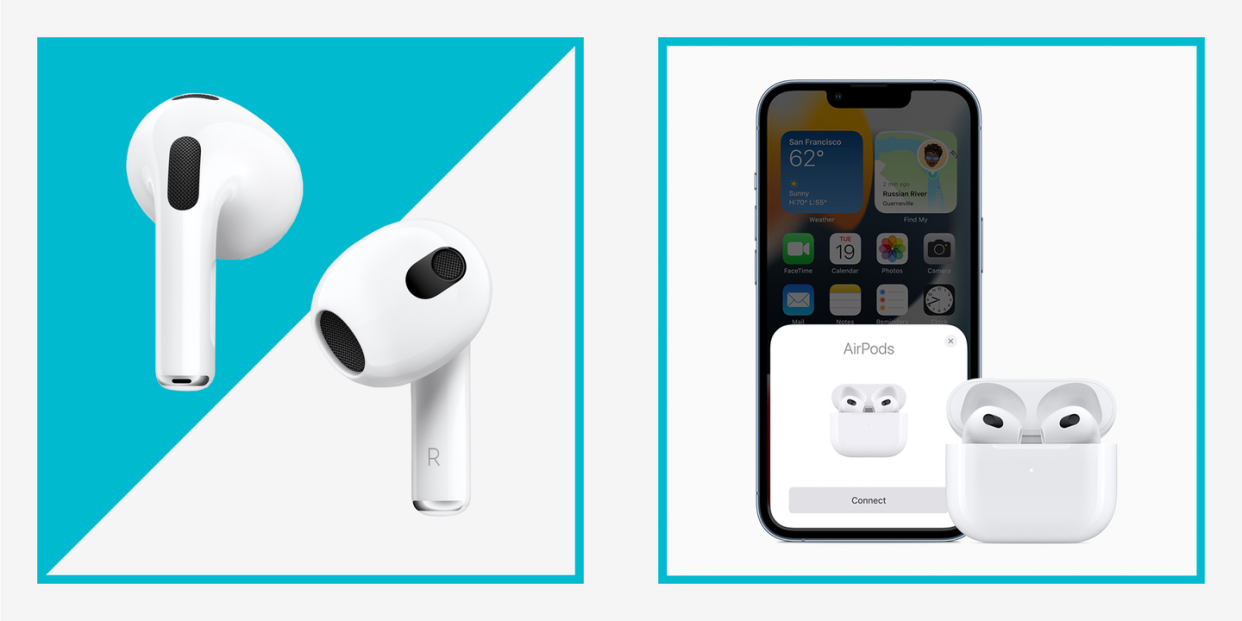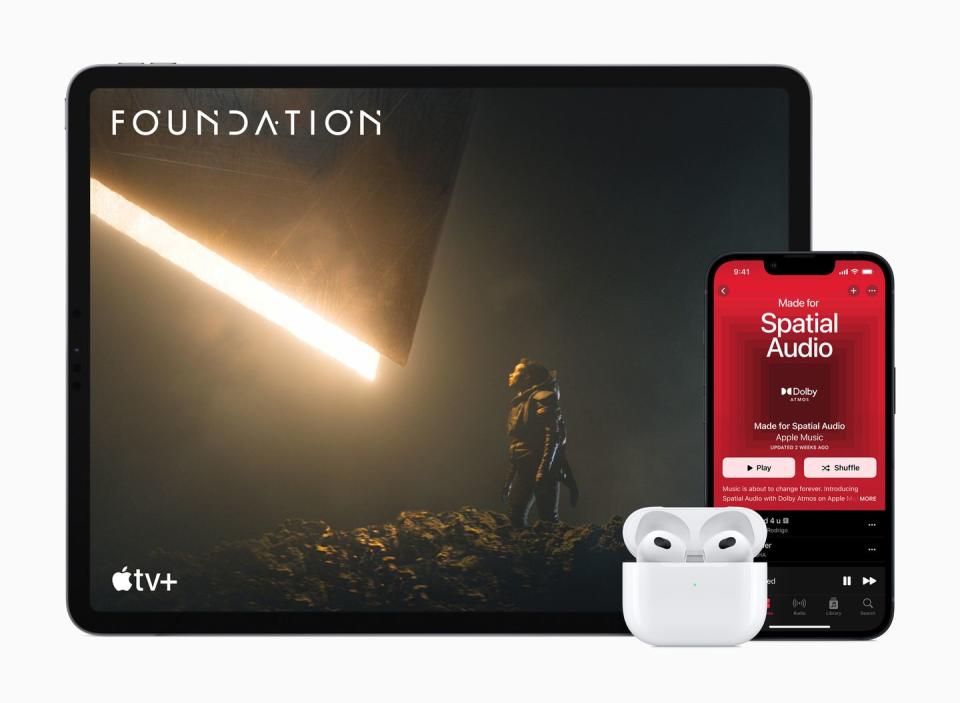Apple's New AirPods Are a Major Leap Forward

Even though AirPods are among the most popular consumer tech gadgets ever made, Apple hasn't exactly rushed to push out new versions of its true wireless earbuds. The first iteration dropped in 2016 (back when the concept of walking around with stems sticking out of your ears sounded ridiculous), then the second gen, which introduced only a few internal performance tweaks and an optional wireless charging case, didn't follow until early 2019.
Sure, the AirPods Pro also came out in 2019, bringing silicon tips for an in-ear fit and advanced audio capabilities with a premium price tag—but that's technically separate from the base AirPods lineage. While iPhones and Apple Watches have an annual update schedule, the earbuds have stayed largely the same since they first debuted, roughly an eon ago by tech gadget timelines.
That all changes with the release of the new third generation AirPods, announced last week by Apple at its second hardware event of the fall. Unlike the previous update, the third gen AirPods have visibly morphed, bringing a sleeker, more streamlined look to the base version of the earbuds. But the improvements aren't just aesthetic. I had a chance to test out the new headphones for just under a week ahead of wide availability on October 26, and I found that the sound is much improved, too—and even though they're $70 less than the Pro model, they feel like a premium audio experience.
The AirPods' New Look
Apple finally dropped the long stem design with this generation of the AirPods, instead opting for a shorter protuberance at the bottom of each bud like the Pro model. The carrying case has also morphed to be more like the Pro's—they're not identical, as the third gen's case isn't as wide—with more of a horizontal orientation than the tall, slim cases of the first and second gen. You no longer have to pay a premium for a wireless charging case, as was the case for the second gen, but you can still charge via Apple's proprietary Lightning cable, which wasn't exactly clear during the keynote announcement. Both Apple's MagSafe chargers and normal Qi wireless chargers work, too.
Along with the aesthetic differences, Apple toughened up the AirPods. They're now water and sweat resistant, with both the buds and the case boasting an IXP4 rating. I took a few walks outside in the rain with my dog, and the headphones handled the drizzle much better than she did. Sweaty workouts weren't an issue either.
Wearing the New AirPods
I almost don't feel like I'm wearing headphones when I use the new AirPods. I've been using in-ear buds for the bulk of my listening lately, and I still get a bit uncomfortable after having the silicon tips sealing off my ear canal after prolonged usage. Switching back to a bud without that fit has been almost refreshing, giving my ears a little more room to breathe.
That doesn't mean it's a loose fit. I took on multiple styles of workouts wearing the buds, from overhead weightlifting movements to shadowboxing to running. I even kept the buds on for extended bouts of rough housing with my dog and her favorite stick, which is more of a high contact sport than you might expect. The only time I knocked a bud out of place was when I took off a long sleeved shirt after overheating, and completely forgot that I even had anything in my ears that could be displaced.
Using the controls on the stems is easier than in previous iterations; the new AirPods have the same force sensor spots as the Pro model and uses a system of quick squeezes to play, pause, skip, or call up Siri. There's no noise cancellation or "Transparency Mode" like the Pro, and I did notice more ambient sound leaking in when I was outdoors and listening to quieter tunes or a podcast or audiobook. Once I cranked up a good song, though, I was able to focus on the music just fine.
The Sound of the New AirPods
The third gen AirPods' biggest advancement is in the audio experience. Along with a new custom driver and high dynamic range amplifier, the headphones add spatial audio, Adaptive EQ, and head tracking (features already available in the Pro line), which Apple claims can make the listening experience more customized to each user and how the earbuds fit.
These smart sound features really stand out, especially with Apple's specialized features at work. I took a three-way FaceTime call to test the spatial audio feature, which aims to create a surround sound experience with the buds by using "spatial algorithms" to upend the standard stereo audio experience (which pipes sounds to either the left or right sides of the device). I'm no audio engineer, so I can't explain the technical wizardry going on here, but it was actually remarkable. If I closed my eyes and didn't look at my phone screen, I could still tell where each person was in relation to me, but not because their voice was only directed into one side of my earbuds. I could just place where they were like I would be able to if they were both standing directly in front of me.

Playing music amplified the spatial audio feature, thanks to tracks on Apple Music mixed in Dolby Atmos, which takes advantage of these new techniques and technologies for the all encompassing sound (Dolby Atmos is also available on Amazon Music and Tidal). I flipped from non-Dolby Atmos tracks to those recorded in the new format, and the difference was obvious—it's easier to pick out different layers within a song, and the percussion sections really stand out. I picked through some of the Apple Music playlists—a song like "Tom Sawyer" by Rush was almost overwhelmingly rich, with so many different layers of sound in one track. I switched to hip-hop and put on "A Milli" by Lil Wayne, a song I nearly blew my speakers out listening to in high school. Thankfully, the AirPods handled the bass much better. This is the type of experience I expect with a set of expensive over ear cans marketed to audiophiles, not from basic earbuds.
Are the New AirPods Worth an Upgrade?
Apple upgraded the AirPod's battery life along with the improvements to the audio and aesthetic components. The company estimates that you'll get six hours of listening use per charge, while the case can store up to 30 hours of juice on its own. I was able to go for days without topping off the case on one of my charging stations, and when I did have to juice up, setting it down while I still had the buds in my ears made the experience seamless.

The third gen AirPods release widely on October 26 for $179, which is a similar cost to other true wireless buds on the market (if you really want to save some money, the second gen is available for $129). That said, many of those similarly priced buds have some form of noise cancellation at that price point, but you'll have to jump up to the AirPods Pro for that capability from Apple's devices.
For the casual user though—especially if you're already have an iPhone and any of Apple's other products—the AirPods are your best option at the price. I would put the third gen AirPods on the same level as the AirPod Pro. The only difference for me was the lack of noise cancellation and the in-ear seal, which I don't always want or need. For most situations, everything the new AirPods offer are more than enough.
You Might Also Like

